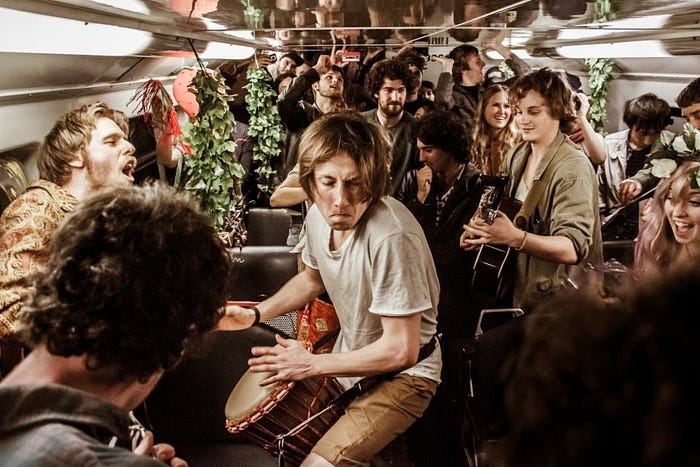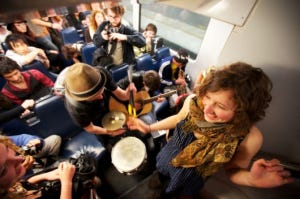Are you a culture hacker? How Train Tracks hacked the commuter experience

It is Thursday night in Sydney, and you are heading home after a busy day at the office. You catch the 7.25pm train at Central Station and stare out the window as it slides under the CBD like a giant snake with its belly full of commuters. As usual on public transport, your fellow commuters ignore one another, browsing apps on their phones and staring blankly into space. You reflect how strange it is that, night after night, thousands of people sit crammed together in these tiny carriages and pretend they are all alone.
The doors open at Wynyard Station and a bunch of young bohemians jump on board. Musicians by the looks of it. You silently tut-tut as they throw their amps and cases down on the empty seats across from you. Don’t they know that’s where people sit? Now they are pulling out guitars and ukuleles and — what? — tuning up, as if preparing for a gig.
With a dop-dop-dop, a bongo player comes bouncing down the stairs, grinning as he salutes the rest of the troupe. Behind him come two girls trailing garlands of leaves and a cloud of colored balloons. You watch, perplexed, as they pin the garlands to the carriage roof and tie the balloons to the seats. 'Don’t mind me’, one of them chirps as she reaches up to fasten a sheet of red cellophane over the light above your head.
As the train glides across the Harbour Bridge, the musicians switch on their amps and launch into a warm-up groove. The ukulele player starts whistling a tune. A jaunty rhythm fills the carriage. You glance around at your fellow passengers, who are looking as surprised as you are. One woman is filming the musicians on her mobile phone. What is going on?
A bushy-haired young man appears at the front of the carriage and clears his throat. ‘Ladies and gentleman’, he announces.
My name is Shay Koren and I am from an organisation called Train Tracks. For the next 30 minutes we will be taking over the train and infusing it with lots of musicians and artists. At the next station, hundreds of people will jump on board.
This is not a riot. We are going to have a party.
Your carriage will have two people wearing sombreros. They will be your carriage managers. If you have any problems please talk to them and they will assist you. The upstairs levels of the carriages are not being used. Head up there if you are not interested in taking part in the experience.

Sure enough, at Milson’s Point station, the party begins. The carriage doors open and an enthusiastic horde of young people pour into the carriage. Their bodies cram the narrow space. The band picks up the groove and everyone starts clapping along. People are hooting and dancing in the aisle. You can forget about reviewing that spreadsheet, you reflect. But you feel relieved, rather than annoyed. The universe just gave you a great excuse to have fun.
The party on Sydney’s Northern Line in March 2014, was not the first Train Tracks event, nor was it the last. Between 2011 and 2014, Train Tracks staged a series of initiatives on Sydney public transport, each more ambitious than the last.
They did it hacker-style, without official approval, taking transport authorities and commuters totally by surprise. Their interventions transformed trains, boats, and city parks into dynamic, shared environments where people created magic together and everyone was a participant.
Train Tracks ran its first event in 2011. Steve Bachmayer, Eloise Boutry, Dean Ginsberg, and Shay Koren, four friends and key members of the organizing team, had no budget and no idea how the event would turn out. They simply thought that staging a pop-up gig on a public train seemed like a cool thing to do. They rustled up some local bands, invited their friends on Facebook, and wound up with over 100 guests taking the ride. It was fascinating to observe how their fellow commuters responded to having their train ride culture hacked. Steve reminisced about a guy in suit who got on at Redfern station, where the team initially embarked. He remained in his seat when they told him there were going to be bands on the train and wound up travelling with them all the way up the line. He bought a ticket at the other end so that he could travel south with them again. ‘He was our first fan’, Dean observed.

The whole thing was an experiment. It is not illegal to play music in a train carriage in New South Wales, so long as no one complains. Train Tracks stipulated to its guests in the invitation: no alcohol, no drugs, and no money — everything had to be free. So long as the event was a gift economy, they weren’t breaking any laws. Still, the organizing team had no idea how the transport authorities were going to react to the pop-up gig. Shay told me about how, on their first trip, a couple of stops north of Milson’s Point, a guard stuck his head in the cabin door and his jaw hit the floor as he took in what was happening. He was immediately on his mobile phone calling the other guards. But rather than shut down the event, the guards let the party continue. The team later learned that what the guard had been saying on his phone was: ‘Guys, this is awesome! You gotta come check this out’.
Pleased with the success of the first event, and feeling confident they were not going to be summarily shut down, Train Tracks launched a second, more sophisticated Northern Line intervention. Following this, they branched out onto ferryboats, staging flashmob-style music events on Sydney ferries under the lights of the Harbour Bridge. They were building a tribe of followers and supporters and gathering positive reviews in the local press, and they had yet to be approached by a single authority to tell them to quieten down or disperse. They had learned that with the right cultural signifiers — colored lights, costumes, flowers, and toe-tapping music — they could put people at ease. By signalling to commuters what was going on and ensuring there were always space hosts on hand that people could talk to, they had learned to create safe and inclusive environments and pop-up parties that rocked.
By 2014, the team was ready to stage a major intervention. On March 13, with the help of dozens of volunteers, and the enthusiastic participation of an army of local musicians, poets, artists, designers, and social entrepreneurs, Train Tracks launched Locomotion, transforming the 7.48pm train from Milsons Point to Wahroonga into a pop-up art and culture festival.
Locomotion was the culmination of a summer series of events made possible through a successful crowdfunding campaign. It was the final event that the team would stage on the Northern Line, and certainly the most spectacular. The 500 people who boarded the train at Milson’s Point that evening had no idea what to expect. They’d simply been told to turn up at the station, set aside a few hours, and expect the unexpected. The carriage hosts were waiting on the platform, wearing sombreros. They corralled the attendees into the middle of the platform, so that they boarded the train on the carriages containing the performers who’d already embarked at Wynyard.

Each of the four carriages hosted a different set of acts. There were live bands in one carriage, stand-up comics and poets in another, and a pop up art gallery with a DJ in a third. IdeaBombing Sydney set up an ideation space in the fourth carriage, inviting people to contribute their ideas towards improving Sydney’s nightlife by pasting them on sticky notes on the carriage wall. All told, it was a vibrant celebration of Sydney’s creative arts scene. As Shay related to a reporter from the Daily Telegraph, who ran an article on the event the next day, it transformed a set of mundane spaces into ‘something exciting and beautiful’.
The Train Tracks team are culture hackers. Through their pop-up experiments, they seek to shake people from their workaday daze and remind them of their power to reinvent their social and cultural environments.
Culture hacking isn’t just a fun idea. We need more culture hackers today, on our trains, buses, ferries and streets to change the world. Our cities are home to some of the most well-educated, talented, creative people in history. Yet so much potential remains untapped. We are slaves to the conventions of the 20th century. We need culture hackers to wake people up and remind them of the power we have to refigure our lives and reinvent society.
We need culture hackers to transform society from a society of mass consumption to a society of mass innovation. Nobel prize-winning economist Edmund S. Phelps argues that if Western societies are to recover the economic dynamism they enjoyed in the 19th century, they need to be ‘energized by homegrown innovation from the grassroots on up’. Culture hacking, in this light, has important implications. While politicians and business leaders pay lip service to innovation, culture hackers make space for it. They do not bother asking for permission. Their mission is too important for that. They are hacking the mindsets and cultural maps of ordinary people to set up physical, social, and cultural environments for gifting, collaboration and innovation.
If your office has the creative ambiance of a commuter train, it needs to be hacked. Someone needs to run a pop-up experiment to change the status quo. Steve Blank argues that companies that refuse to hack their cultures inevitably ‘doom’ the innovation efforts they set in motion. These companies consign themselves to ‘innovation theater’ rather than genuine innovation. They run workshops, hire speakers, and spend hundreds of thousands of dollars on flashy space design. But they refuse to disrupt the cultural norms of their organisation. The innovation theater counts for nothing, because at the end of the day, the office remains an office.
This is a recipe for irrelevance. These companies may fend off their competitors in the short term. But, sooner or later, someone is going to drink their milkshake.
The job of the corporate culture hacker is to do for the office space what Train Tracks does for the city commute. Blank compares this to ‘waging psychological warfare’ on a company. This sounds unnecessarily violent. If Train Tracks teaches us anything at all, culture hacking can be a lot of fun. We need to turn workspaces into innovation spaces. We need disrupt cultural norms and make space for creative, experimental, entrepreneurial activities.
